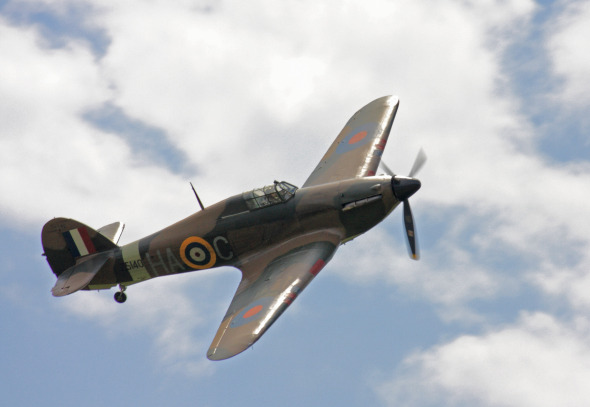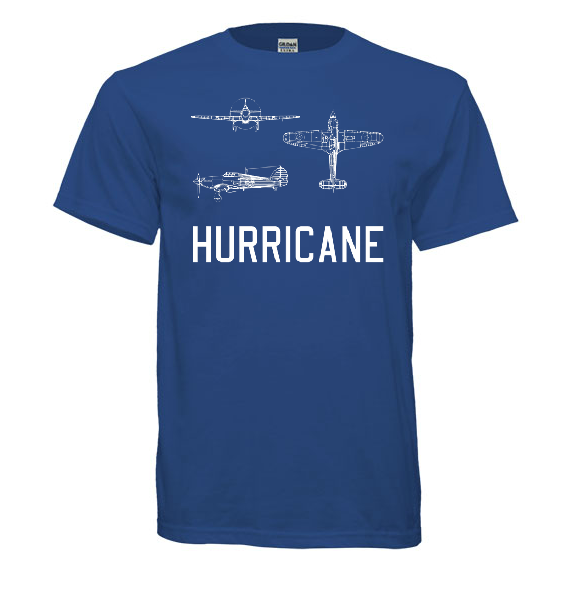
Not talking about storms here, but one of the greatest fighter planes of World War II. While its fame was later eclipsed by the Supermarine Spitfire, the Hurricane played a major role in early air conflicts, especially the Battle of Britain. Produced from 1937 to 1944, it served throughout most of the war and racked up some pretty impressive facts and figures.
There’s 72 Hours Left to buy our tribute to this iconic airplane. Available in men’s, women’s, v-neck, long sleeve, hoodie and sweatshirt starting at $16.99 and shipping worldwide from the USA. Makes a great gift for Dad or Grandpa!
Eagle Squadron
Before the US’s entry into the war, many Americans joined the Royal Air Force and formed the Eagle Squadrons. As this took place at the beginning of the war, the American pilots mostly flew Hurricanes. In 1941 after the US declared war on Germany, these squadrons were folded into the US Army Air Corps.
Outnumbered but Not Outgunned
During the Battle of Britain in July 1940, the RAF had a total of 527 Hurricanes and 321 Spitfires to face the Luftwaffe’s 2,700 planes. Ultimately, the British forces were successful in destroying 1,887 aircraft to British losses of 1,547 planes over the three-month period. Their success marked a turning point for Britain and the war, halting the Nazis’ advancement in Europe.
Takes a Lickin’
While slower and less agile than the Spitfire, one of the Hurricane’s saving graces was that it was known to hold up better against enemy fire. In the Battle of Britain, they helped provide cover for the Spitfires, taking the brunt of the damage as the Spitfires moved in for the kill.
Important Technical Figures
Maximum Speed: 340 MPH
Range: 468 miles (1,090 miles with two 90 gallon ferry tanks)
Ceiling: 35,000 feet
Wingspan: 40 feet
Length: 31 feet, 4 inches
Height: 13 feet
31 Flavours of Death
Aside from the standard Mark I Hurricane, there were several other models that varied depending on their mission. Besides the Mark II(A&B), there was the Mark II Trop (rigged for combat in North Africa), the Sea Hurricane (modified to be launched by catapult for convoys), the Hurricane Hotspur (with a turret gun placement), the Typhoon, and many other variants.
Practicality
With the Great Depression going on at the time of its development, Chief Designer Sydney Camm tried to use as many pre-existing parts and manufacturing techniques as possible. This resulted in a plane that was essentially the monoplane successor to the Hawker Fury biplane.
Easy to Repair and Modify
These practical concerns in building the Hurricane meant that it could be easily repaired after battle. It also allowed for the heavy modification that led to so many different models, making it a highly suitable fighter for almost any theatre in the war.
Hazardous to Your Health
And not just because of the Nazis shooting at you. Hurricanes had a problem with carbon monoxide fumes seeping into the cockpit. Manufacturers attempted to fix this by outfitting the planes with longer exhaust stubs and other modifications, but nothing ever completely alleviated the problem. Instead, pilots were required to use oxygen from engine start-up to engine shut-down.
A Throwback?
Of all the various modifications to the Hurricane, one of the more interesting was a one-off biplane variant. Known as the Hillson FH.40, the top wing was meant to hold extra fuel, reducing takeoff distance and increasing ferry range. However, it proved too heavy to be serviceable and none were built beyond the original.
Only a Handful Remaining
Of the 14,583 Hawker Hurricanes that were built during the seven-year period of production, only 13 survive that can still fly. However, many that are not in airworthy condition, are on display at museums all over the world. There is even one at the Smithsonian Institution’s Udvar-Hazy Center at Dulles Airport, which is part of the National Air and Space Museum.



